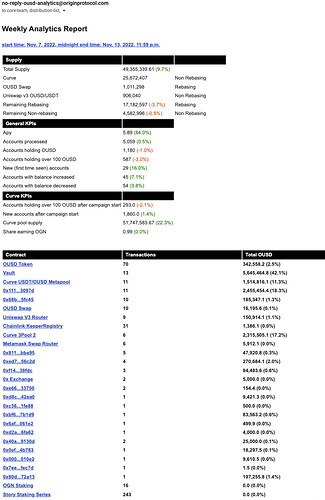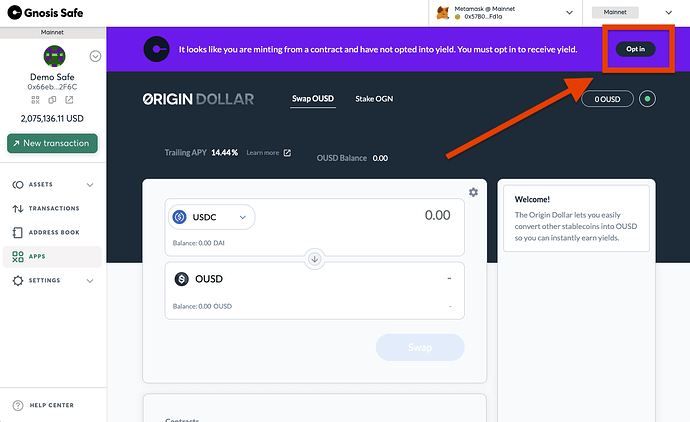TLDR
Convert x% of $RARI into OUSD for DAO treasury diversification and yield generation
Problem / Opportunity
The Rarible DAO treasury, consisting mainly of $RARI tokens, grows only with price appreciation of the $RARI token. By converting a portion of the $RARI into OUSD, the DAO will diversify the treasury, adding protection against unfavorable market conditions, and will generate yield, extending the runway of the DAO passively.
The Origin Dollar (OUSD)
OUSD is an ERC20 stablecoin that generates yield while sitting in your wallet. Backed 1:1 by USDC, DAI, and USDT at all times; holders can go in and out of OUSD as they please. Yield is paid out daily and automatically (sometimes multiple times per day) though a positive rebase in the form of additional OUSD, proportional to the amount of OUSD held. OUSD yield, currently ~5% APY, comes from a combination of:
- Lending collateral to Aave, Compound, Morpho, Curve, and Convex
- Reward tokens (AAVE, COMP, CRV, and CVX) are automatically claimed and converted to stablecoin
- A 25bip exit fee is charged to those who choose to exit OUSD via the dapp (completely avoidable if using DEX or CEX), this fee goes back to OUSD holders
- OUSD sitting in non-upgradable contracts (more than half the OUSD in existence) does not rebase, instead the interest generated from those tokens is provided to those that can rebase
These 4 yield generating functions combined enable OUSD to generate higher yields than lending directly to any single protocol manually. Each week a governance vote is held to determine the best allocation of OUSD collateral between the whitelisted strategies, voted on by OGV holders. OGV is the governance token for OUSD, and any token holder can participate in these votes after staking their OGV for veOGV. OGV holders also have the ability to propose new yield strategies for OUSD.
There is no set emission schedule for OUSD - similar to stETH, OUSD is minted on demand when users lock their stablecoin into the protocol, and burned on demand when users exit OUSD for the collateral stablecoin. OUSD is completely non-custodial, there are no lock-ups, terms, or conditions. Any web3 wallet should be able to support OUSD and its rebasing function, including hardware wallets and multi-sigs. There’s no need to ever again give up the keys to a 3rd party platform, such as Celsius, Blockfi, or FTX, to earn yield.
In early 2022, OUSD reached a market cap $298m, with no issues, and without diminishing the daily rebase payments; OUSD can easily function with scale. Since OUSD is backed 1:1 by its collateral assets at all times, and OUSD and its collateral are stablecoins, OUSD market cap = OUSD supply = OUSD TVL. The current OUSD market cap is ~$34.8m as of April 3 2023, growing each day with each rebase.
Estimated Return
Please use this calculator to estimate the OUSD return per month and per year over 16 quarters. On the calculator, cells in green are investments made at the beginning of the month (if the DAO would like to initiate recurring conversions into OUSD) while cells in orange are months with no additional OUSD investment. Parameters you may want to change and explore in the calculator are cells B70 - B73, B76 - E79, and B81 (outlined in bold boxes). To change the OUSD APY, investment amount, or test transaction amount, select File > Make a Copy.
Monitoring and Reporting
Occasionally, DAOs choose to appoint a delegated treasury team to help keep track of the OUSD investment, participate in the weekly allocation votes, and initiate the investments into OUSD. While there is no need to actively manage an OUSD position due to the automated features of OUSD, Rarible may want to appoint a similar treasury team.
Monitoring of the current OUSD APY, strategies, and backing collateral, is always available in real time on the OUSD Analytics page. A three month day-to-day OUSD APY can be seen on this page on the analytics site, updated daily, while a longer history of the OUSD APY is available via this Dune query. API endpoints containing OUSD data are also available via the API page of the OUSD docs. To assist with reporting and decision making, the core team and community can use this link to join the distribution list that will receive a weekly OUSD analytics report. Here is an example analytics email from November 2022:
Contracts/Technical Requirements
Very little technical work is necessary to execute this proposal. The OUSD dApp is already available within the Gnosis app catalog. Rarible will first convert the $RARI tokens into stablecoin, then into OUSD using the OUSD dApp within Gnosis, and finally will “Opt in” to yield generation by clicking the Opt in button within Gnosis or by calling the rebaseOptIn() function.
A screenshot of the Opt in button on Gnosis can be seen here:
Use of funds
Funds converted into OUSD will be deployed across the various audited strategies for yield generation. There are no KYC, KYB, or partnership requirements to earn yield, all that is necessary is to hold the tokens in a rebase-capable wallet.
Security Considerations
Risk Mitigation
There are four risks when using OUSD, and Origin is making sure to reduce each risk as much as possible:
Counter-party risk - OUSD is governed by stakeholders around the world. Everything from yield generation to fee collection and distribution is managed by a set of smart contracts on the Ethereum blockchain. These contracts are upgradeable with a timelock and are controlled by hundreds of governance token holders. While the initial contracts and yield-earning strategies were developed by the Origin team, anyone can shape the future of OUSD by creating or voting on proposals, submitting new strategies, or contributing code improvements. We intend for all important decisions to be made through community governance and all smart contracts are now owned by the DAO.
Smart contract risk of the yield strategies - Origin is only using platforms for yield generation that have a proven track record, have been audited, have billions in TVL, maintain a bug bounty program, and provide over-collateralized loans. Over-collateralization in itself, combined with liquidations, provides a reasonable level of security for lenders.
Stablecoin risk - Origin has chosen 3 of the largest stablecoins to ever exist to back OUSD, and they have stood the test of time and maintained their peg quite well through multiple bull and bear cycles. They have also demonstrated significant growth in circulating supply, so the Origin team is confident that the 3 stables will maintain or re-gain their peg and that OUSD will remain stable. OUSD is also using Chainlink oracles for pricing data for DAI, USDC and USDT to ensure accurate pricing at all times. In situations where DAI, USDC and USDT fall below the $1 peg, OIP-4 disables minting of additional OUSD tokens using the de-pegged asset.
Smart contract risk of OUSD - Origin is taking every step possible to be proactive and lessen the chance of losing funds. Security reviews of OUSD are prioritized over new feature development, with regular audits being done, and multiple engineers are required to review each code change with a detailed checklist. There are timelocks before protocol upgrades are launched, and deep dives into the exploits of other protocols are constantly being done to make sure the same exploits don’t exist on Origin contracts. Security is extremely important to the Origin team. 7+ audits have been done since 2020, all of which can be seen on Audits - OUSD, and OpenZeppelin is now on retainer. On-chain insurance protocol InsurAce awarded OUSD the highest possible security rating of AAA, of which only four projects on the InsurAce platform have received. Origin also holds two of the top four spots on the Immunefi leaderboard when sorted by average response time to pay or close a bug bounty.
Test Cases
A test case for converting idle DAO treasury assets into OUSD can be seen with Popcorn Network:
- Proposal - [PIP-14] Treasury Management with OUSD
- Token swap transaction: Ethereum Transaction Hash (Txhash) Details | Etherscan
- Recurring yield to the treasury: Popcorn Yield
OUSD is going through the governance process for DAO treasury investment with several other DAOs, including:
- Rook - Treasury Utilization Opportunity with OUSD
- Aavegotchi- Origin Protocol’s OUSD for Treasury Yield
Several OUSD integrations are also in process, including:
- Aave - Add support for Origin Dollar on Ethereum V3
- Ondo - Adding OUSD Support
- dForce - Proposal to add OUSD as a Supply/Borrow Asset
- PoolTogether V5 - Using OUSD for yield generation
Peg Stress Test
Since OUSD is partially backed by USDC and DAI, the price of OUSD also fell below $1 for a period of time during the weekend of March 10, 2023. During this time, arbitrageurs were able to buy OUSD at the cheaper price on AMMs, then redeem the OUSD via the dApp into a basket of stables (USDC, USDT and DAI), which they sold back to the market for a profit. With each dApp redemption, OUSD collected a fee (#3 on the yield generation section above), and there were lots of redemptions during this weekend. When the price for USDC and DAI returned to peg, the entire cost was borne by those that sold their USDC and DAI for less than $1. If the price stayed down, LP’s will have traded more valuable OUSD for the less valuable USDC, and will have taken a loss.
In either case, OUSD holders have more stablecoins than they started with, with external parties bearing both the risk and the loss. OUSD holders made a total of $120K in yield during the market events. OUSD APY increased from ~4.6% to ~42% (7-day trailing) and was trading back at 0.99 within 17 hours of losing its peg. The 1/3 backing of OUSD by USDT helped prevent the OUSD peg from falling as low, and for as long, as USDC and DAI.
As mentioned earlier in the proposal, in situations where the price of DAI, USDC or USDT fall below $0.998, OIP-4 disables minting of additional OUSD tokens using the de-pegged asset. OUSD fully restored to $1 within 36 hours as opposed to USDC and DAI which remained severely depegged for almost 3 days.
Many members of the Origin team, including both founders, are holding a significant portion of their personal wealth in OUSD. Origin Protocol’s corporate treasury is also holding millions of dollars in OUSD. We have skin in the game and are willing to put our own money at risk with the code we have written.
Team Members
- Peter Gray: BD Manager. He has been with Origin Protocol for the past 9 months and has been researching/experimenting in the blockchain space since 2013.
- The full Origin Protocol core team is available on the Origin website
The contact person for this project will be Peter. His contact information is peter@originprotocol.com and his Discord handle is SlagathorTheMammothKing#7632.
Origin was founded by Web3 veterans Josh Fraser and Matthew Liu in 2017 and is one of the most venerable projects in the space. Josh and Matthew are joined by the fully doxxed Origin team and community, which includes hundreds of thousands of members and open-source contributors. Origin has raised $38.1M from top investors including Pantera, Spartan Group, Foundation Capital, BlockTower Capital, Steve Chen, Garry Tan, and Alexis Ohanian, and currently maintains a multimillion dollar treasury.
Accountability
Peter will attend each community call to provide updates on OUSD. Potential updates may include OUSD yield over the past week, total yield generated for the DAO, and/or new OUSD yield strategies. If Peter is unavailable, someone else from the Origin team will attend the calls to provide updates.
Origin Protocol links:


